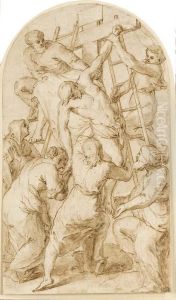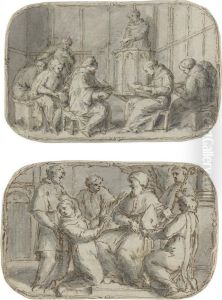Ferdinand Delamonce Paintings
Ferdinand Delamonce was a French architect and engraver, born in 1678 in a period characterized by the Baroque style, which was gradually giving way to the more restrained and classical Rococo style. He is not as widely recognized as some of his contemporaries, but he contributed to the architectural landscape of his time, particularly in the region of Lyon, France.
Delamonce was trained as an architect and developed his skills in an era when the profession was undergoing a transformation, with the rise of academies and a growing emphasis on classical principles. He became a member of the Académie de Lyon, which played a significant role in his life and career. His work is noted for its classical approach, with an emphasis on symmetry, proportion, and the use of motifs derived from ancient Greek and Roman architecture.
Although Delamonce's oeuvre includes various projects, one of his most notable contributions to architecture was his involvement in the design of the Place Bellecour in Lyon. This vast public square is one of the largest of its kind in Europe and is a prime example of the classical French urban design of the 18th century. Delamonce's vision helped to shape the square's uniform façade, which was intended to reflect the glory and power of Louis XIV.
In addition to his architectural work, Delamonce also made a name for himself as an engraver. His engravings were primarily architectural in nature, serving as records of designs and ideas as well as tools for disseminating the classical ideals of architecture. These engravings not only illustrate his technical skill and attention to detail but also provide insights into the architectural trends and preferences of his era.
Ferdinand Delamonce passed away in 1753, leaving behind a modest but important legacy within the context of French architecture. His works continue to be studied by those interested in the development of classical architecture in France and the transitions that occurred between the Baroque and Rococo periods.

